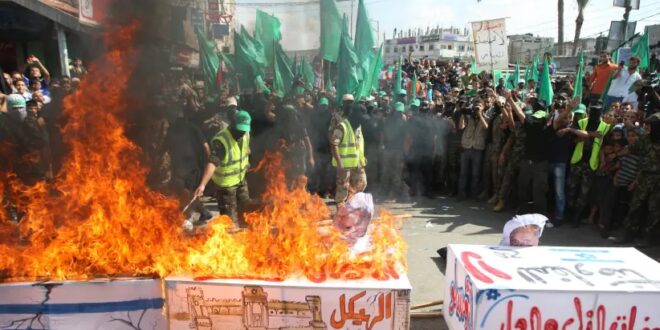Iran, Hezbollah and Hamas coordinated messaging on Quds Day on May 8, claiming Israel could be defeated in one large tactical operation; a week later, it seemed to be working.
Lebanese protesters, likely urged on by Hezbollah, tried to breach an area of a border fence in northern Israel on Friday near Metulla. In Lod, Israel continued a curfew after nights of violence that had the city looking like it was suffering a civil war.
In Gaza the IDF struck another Hamas anti-tank squad, one of a half dozen such units targeted in recent days. On the Jordan border, demonstrators supporting the Palestinians tried to break through to reach Israel and the West Bank. Israel is now facing a four-front conflict – its internal strife, Gaza, Lebanon and Jordan – and possibly more violence in Jerusalem and the West Bank.
It all began in April with the start of Ramadan and attacks on Jews were filmed on TikTok. Then, far-right rallies in Jerusalem and clashes and police closures of Damascus Gate led to further tensions. By early May, tensions grew. Prime Minister Benjamin Netanyahu had to hand back his mandate to form a government and President Reuven Rivlin handed the mandate to Yesh Atid’s Yair Lapid on May 4.
Four days later, Israeli police battled with Palestinians in Al-Aqsa mosque. Bahrain, the UAE, Jordan and other states expressed concern about the Al-Aqsa clashes and Israeli police actions were condemned.
Iran, Hezbollah and Hamas coordinated messaging on Quds Day on Saturday, May 8, claiming Israel could be defeated in one large tactical operation. Shooting incidents in the West Bank had increased and one Israeli died of his wounds. Israel beefed up forces in the West Bank.
On Monday, May 10, clashes in Jerusalem took place amid Jerusalem Day, the anniversary of Israel’s 1967 regaining of the capital from Jordan, and Hamas decided to launch rockets at Jerusalem in solidarity with Sheikh Jarrah and Al-Aqsa. This was the beginning of the Hamas rocket war which saw 2,000 rockets fired in 72 hours.
By Friday, a major conflict was developing on the border of Gaza. Israel carried out massive airstrikes. Jerusalem said that “throughout the night [of May 13-14], approximately 160 IDF aircraft from 12 squadrons struck over 150 underground targets in the northern Gaza Strip.”
Parallel to the Air Force strikes, ground forces, artillery and armored troops deployed along the border and fired hundreds of artillery shells and dozens of tank shells against targets in the Gaza Strip.
IN LOD, the mayor said Jews faced a pogrom, synagogues were attacked and the Border Police were called up and redeployed to the town from the West Bank. Suddenly the war had moved to Israel’s streets.
Lynchings took place, Route 65 and other major roads were closed as rioters from Rahat to Umm al-Fahm targeted traffic, and Jews attacked an Arab driver in Bat Yam. In other cities from Haifa to Nazareth, Nahariya, Ramla and Jaffa there were clashes. Mobs roamed the streets; police were unable to control the chaos. Israel’s media said anarchy had come to many towns and cities in Israel.
Then on May 14, as Ramadan had ended, the conflict shifted to Jordan and Lebanon. In Lebanon on May 13, a Palestinian group fired several rockets, apparently out to sea, but warning Israel. In Jordan, demonstrators came to the border to try to break through.
Israel’s chilly relations with Jordan and Netanyahu’s terrible relations with its king likely led to Jordan enabling the demonstrators. Hezbollah runs half of Lebanon and encouraged the demonstrators to target the border area. The terrorist group has long planned to attack Israeli communities and seize them in time of war. Iran watched closely and noted that the region has now pivoted and the balance has shifted against Israel.
A week after IRGC head Hossein Salami had predicted Israel could be beaten in one operation, it appeared his multi-front war strategy was coming true. Airlines cancelled flights to Israel. Rockets were raining down, most intercepted by Iron Dome, but Netanyahu, Israel’s military strategists and high command had no answer to the massive and increasing rocket threat.
Buried in the sand dunes and with longer ranges than in the past, Hamas was purposely targeting infrastructure with rockets, as well as cities and Iron Dome, it said. Meanwhile, it unleashed anti-tank teams along the border to threaten Israeli vehicles.
By May 13, Yamina leader Naftali Bennett, who had claimed he would form a government with Lapid on May 4, had thrown in the towel and said no change in government was possible. Netanyahu, in power for more than a decade, was watching the borders burn with protesters assaulting the border fences, Israeli cities in flames as mobs attacked people, border police having to be called from the West Bank, clashes in the West Bank and Gaza, and calls in the US to end military aid to Israel.
Israel’s multi-front war had exploded in its face with no strategy to confront it – and years of ignoring issues, such as the Kingdom of Jordan’s, coming back to haunt Jerusalem.
 Eurasia Press & News
Eurasia Press & News




